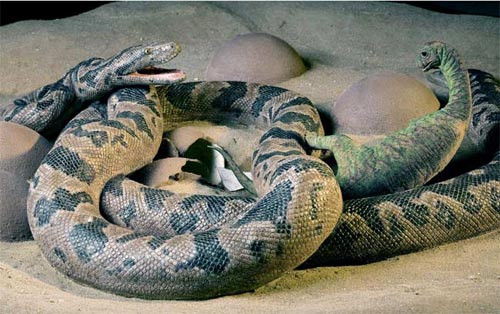Soap with baby dinosaur meat
According to the researchers, the final image that hundreds and thousands of newly hatched dinosaurs are giants. If escaping from the python species about 4m long, they can grow as fast as blowing and up to 18m long.
Recently, Indian, American and Canadian scientists studied the nearly intact fossil of a 67-million-year-old snake, nearly 3.4m long, curled around a broken egg shell next to a giant baby dinosaur. Long necks eat plants - the largest animal ever on earth.
"We think the dinosaur has just come out of the eggshell and that activity has attracted the snake ," said Dhananjay Mohabey, a paleontologist at the Indian Geological Survey.
The fossil discovery site located in the westernmost state of Gujarat has traces of hundreds of long-necked dinosaur eggs, each with 6-12 eggs. Two other giant snake fossils are also found at the egg nests. This shows that this serpent species specializes in eating baby dinosaur meat.

Preparing giant snake to re-hatch newly hatched dinosaurs (Image: Tyler Keillor, Ximena Erickson)
'It's really a banquet. During the hatching season, hundreds or thousands of small, long-necked dinosaurs that are unable to defend themselves may have become prey to carnivores', Jason Head, a paleontologist at the University of Toronto ( Canada), said.
Dinosaur eggs are located along the two banks of a quiet small branch and are obscured by their mother. The dinosaurs of their parents did not seem to care for the children because the researchers could not find traces of the adults.
Bones and fragile structures (dinosaur egg shells, snake's skulls .) are in the same position as in real life so researchers think the snake was buried alive unexpectedly. That may be the result of a sandstorm and mud.
Although the long-necked adult dinosaur is 18m long, the newly hatched animal is only about 46cm long. Therefore, one of the evolving engines makes fast-growing dinosaurs likely to escape the dangerous area full of giant snake-eating predators.
According to Jeff Wilson, a paleontologist at the University of Michigan (USA), one year after hatching, they can be about 2 meters long, too big for snakes to catch.
'Many paleontologists in the early 20th century thought that dinosaurs grew and developed in the typical way of reptiles: growing slowly and living to 60, 70, 80 years old. Recent research shows that they are really fast growing. At the age of 'teenagers', their bodies are as big as three-quarters of the adult's. And they're only '30' or 40 years old, ' Wilson said.
- Soap 'magnet' oil spill cleanup
- Detecting a baby dinosaur nest in Mongolia
- Which meat is the best dinosaur?
- What flavor does the dinosaur meat taste good or not?
- How to bathe your baby safely
- Little 3-year-old dinosaur drowned
- Crocodile eat dinosaur meat
- With this soap, you will never have to worry about slippery, easy to fall again
- The color of 'illusion' comes from the soap bubble
- Animals push back dinosaurs to eat meat with a tail
- The soap is sufficiently colored in red and purple blue, why is it only white?
- The US officially issued a ban on antibacterial soap
 Discovered an ancient centipede fossil 99 million years old
Discovered an ancient centipede fossil 99 million years old Discovered bat-like dinosaurs in China
Discovered bat-like dinosaurs in China Discovered a 200-year-old bronze cannon of the coast
Discovered a 200-year-old bronze cannon of the coast Discover 305 million-year-old spider fossils
Discover 305 million-year-old spider fossils